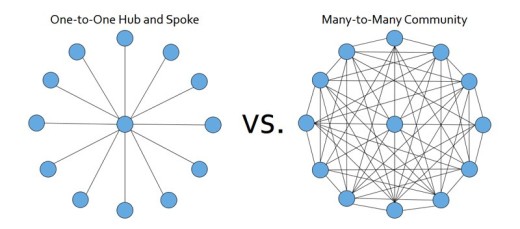
No matter what level of profession you’re in, networking is the fuel to accelerate your success.
Not only is it useful for learning directly from individuals you meet, but the benefits of association and growing your own authority are just as powerful.
For some of us, hearing the word “networking” can leave a bad taste in our mouths.
Many of us aren’t sure where to start, what to say when we connect with someone, nor how to maintain that relationship. Although I truly believe there’s an art and science to networking and building authentic relationships, I’m going to distill what I’ve learned over the past few years.
This is the no nonsense guide to networking.
Stage 1: Mindset
Before you think about networking, remove the word working out of your system.
We hear people talking about putting on their “networking game,” and I can’t help but think how many showers they’ll need to take after to rid the inauthenticity. It’s likely that the people you’re trying to reach get approached by dozens, if not hundreds of people just like you, and it’s not difficult for them to separate the people who are putting on a face.
The best networking comes from genuine relationships, not from a business card exchange. No matter who you’re trying to build a relationship with, treating them as a friend rather than a business contact will take you much further with the relationship.
Think about how you would approach a potential friend.
You’d probably find something you’d have in common with, keep it light, make jokes, and above all, show that you care.
Stage 2: The Destination
Doing something for the sake of doing it is rarely a good idea, nor is it a good use of your time.
It’s the old analogy of having a fully gassed car without the final destination to head towards.
As many of you may already know, I’m a big believer in goal setting and being deliberately focused on pouring all your energy into accomplishing your stated goal.
What is your dream job? How do you envision your future? What would you need to be doing in order to be the most fulfilled, happy, and driven?
Write down what your goal would be five years from now.
Then write down what goal you would need to hit one year from now in order to get you closer to your five year goal. And lastly, write down what goal you would need to hit 90 days from now in order to get you closer to your one year goal.
For example:
Let’s say your goal was to make $1,00,000 USD in five years. Then you would need a vehicle, whether it’s your own business, investments, or something financially viable that will get you to your destination in five years.
In this case, your goal one year from now could be to have your business launched, and to hit $5,000/month of sales.
So what would you need to do in the next 90 days, in order to hit $5,000/month in your new business, one year from now?
It could be finding the right partner with complementary skill-sets, or to acquire your first paying customer in the next 90 days.
5-year goal: Make $1,000,000 USD
1-year goal: Hit $5,000/month ($60,000/year) in sales with new business
90-day goal: Get first paying customer
Now it’s time to write down your goals. Yes, I want you to physically write your goals down!
Stage 3: The Map
Now that we have our final destination five years from now, including focused, short-term goals to get us there, it’s time to design our map.
Keith Ferrazzi has a powerful strategy called Networking Action Plan (NAP) that he explains in Never Eat Alone to connect your networking strategy with your goals.
Step #1 was to write down your goals and final destination (which you completed in Stage 2)
Step #2 is to look at the three goals you have written down. Then next to each of your goals: write down three people that will either kickstart or accelerate your goal.
These could be people you are already connected with, people that are second degree connections from you, or people you have no connections to.
Here are a few examples of who your top three could be:
- Mentors or advisors with specialized knowledge or experience to help guide you through your journey
- Clients who will advocate for you, or prospective clients you are looking to close
- Investors that believe in your vision to fund your dream
- Team members, whether they’re co-founders or key hires that will take your business to the next level
- Boss or managers that could propel you to a raise or a strategic position within your organization
- Superconnectors that will connect you with any of the above to build your network
If you’re looking to start a company, the three people could be a potential partner, investor, and a potential client.
If you’re looking to write a best-selling book, they could be your agent, promotional partners, or your editor.
It’s important to invest some time doing thorough research in order to be confident that the three people you write down are essential in helping you accomplish your goals faster.
Stage 4: Build a human connection
How do you foster a real connection when you speak with someone — whether it’s on Skype, on the phone, or in-person?
Personally, I think it boils down to two factors:
1. Asking insightful questions (that gets the other person thinking)
You can know a lot about a person by the quality of the questions they ask.
Tony Robbins often shares that the quality of your questions is correlated to the quality of your life.
Ask better questions, receive better answers.
Peter Thiel takes it a step further by challenging us to ask ourselves:
“How do we accomplish our 10-year goals in six months?”
This brings about a completely different way of thinking, forcing us to ask questions that challenge and push us to our limits.
By asking better questions when you’re speaking with someone, it not only puts you in a category of someone that thinks differently, but it forces the other person to think in a new way that helps them grow.
“The way that you become world-class is by asking good questions.” — Tim Ferriss
2. Paying attention (like your life depends on it)
This may come naturally for some people, or extremely difficult for others.
If I was to write this article twenty years ago, this may not have made it on the list. However, in the smartphone notification world we live in, it’s a demanded “skill” that so many of us lack.
How many times have you spoken with someone, and they’re either constantly fidgeting, looking around, or interrupting your every damn sentence?
This may sound like a lesson you would receive in elementary school, but it’s clear that there’s a rare breed of people that actually pay attention.
In other words, by simplying maintaining eye contact, listening attentively, and responding back with relevant questions, you’re already separating yourself from the rest of the pack and well on your way to fostering a genuine relationship.
Listen. Ask good questions. Repeat.
Stage 5: Superconnecting
The fastest way to grow your own network is to introduce two people who can benefit from one another. As simple as this may sound, this is an act you hardly see most people do.
When’s the last time someone deliberately went out of their way to introduce you to “this person” and “that person” immediately after they listened to your struggles?
If you’re the rare breed that has experienced this, you’ve met a superconnector.
“Connecting people who can benefit each other is the most useful skill you can have on the entrepreneurial ladder of skills.” — James Altucher
With over three billion people online today, it’s becoming increasingly difficult to separate the fog from the light, and the role of superconnectors will become increasingly important to make that distinction.
Here are five of what I believe are the most powerful ways to become a superconnector.
- Don’t keep score. This is by far the key difference between superconnectors and everyone else. Superconnectors have an abundance mentality, and they’re always willing to give, connect, and share.
- Make friends, not “contacts”. In other words, quality over quantity.
Put away your business cards, and form genuine friendships with people you meet. I force the habit to never talk about business in the first encounter of meeting someone, unless I have to. It’s 10x more valuable to develop connections with 5 quality people at an event, than 50 “contacts” you don’t remember the names of. - Connect other superconnectors. Do you know two connectors that could benefit from meeting? Have they already met? Introducing two superconnectors will be the easiest connection you will make because: they are naturally friendly and will most likely have friends in common. By faciliating this introduction, you’re not only helping others further their goals, but you’re always going to be on top of their mind for future potential connections that will benefit YOU.
Win-win-win. - Interview people. This may be one of the fastest ways to grow your network, if done strategically. You could do this in the form of a research paper, book, or my personal favorite — podcast. Many successful people don’t mind giving up some of their time, if there’s an opportunity to provide value and receive exposure for doing so. I’ve been fortunate enough to connect with the likes of Eric Ries, Adam Braun, Jason Fried, Gary Vaynerchuk, and many others that would have been difficult to connect with, unless I started #SKIM Live. Podcasting is one of the rare mediums that is designed to connect people from anywhere around the world.
- Follow up. This is the missing step that we all forget to do, for various reasons. But following up to see how the introduction went, or randomly following up a few months later with no agenda will not only help you maintain the connections you already have, but it will foster the relationship to a different level.
In a world of take take take, being able to show that you care about someone as a friend will put you in a whole different category with any of your connections.
Can you think of someone you need to follow up with right now?
Read Next: The complete guide to productivity
Image credits: Growthlist, Shutterstock
This post first appeared on the Growthlist.
Get the TNW newsletter
Get the most important tech news in your inbox each week.




